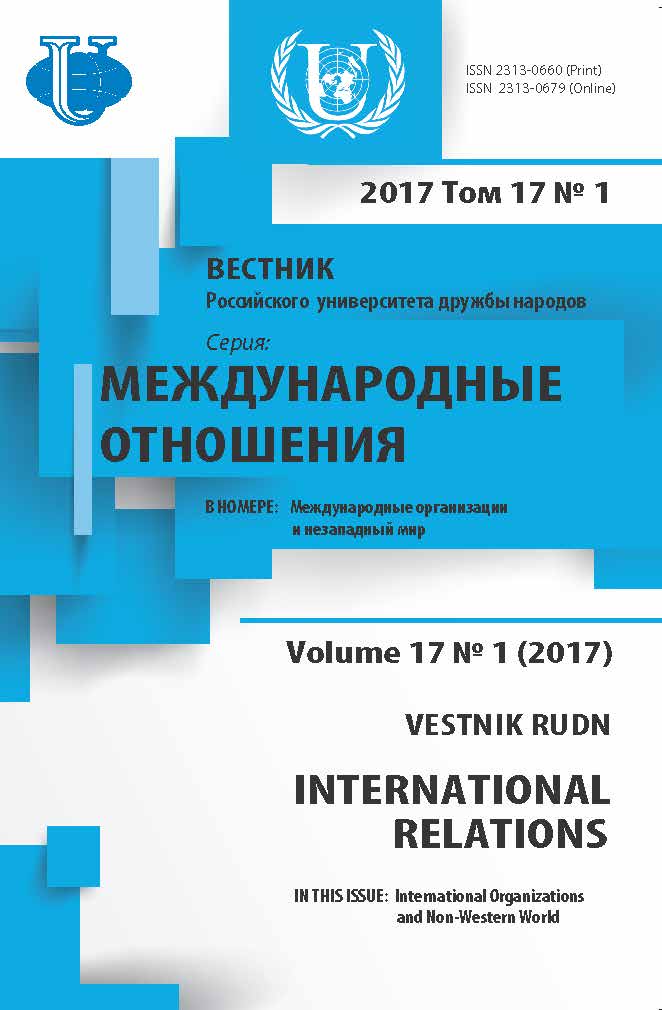Asia-Pacific Economic Cooperation (APEC): Models of Engagement with International Institutions in the Process of Regional Governance
- Authors: Safonkina E.A.1
-
Affiliations:
- Russian Presidential Academy of National Economy and Public Administration (RANEPA)
- Issue: Vol 17, No 1 (2017): International organizations and Non-Western World
- Pages: 122-136
- Section: APPLIED ANALYSYS
- URL: https://journals.rudn.ru/international-relations/article/view/15882
- DOI: https://doi.org/10.22363/2313-0660-2017-17-1-122-136
Cite item
Full Text
Abstract
After the global financial crisis in 2008 the Asia-Pacific region has become a main driver of global economic growth leaving behind the US and European economies. The regional integration processes and business environment improvement as a result of the multilateral regional fora`s activities, such as the Asia-Pacific Economic Cooperation (APEC) laid the foundation for such economic successes. In the process of regional governance the APEC engages with various international and regional organizations applying the models which help it to address its agenda demands in the best way. The article aims to explore what models of engagement with international and regional organizations the APEC forum applies in the process of regional governance; reasons and results of applying these models; track the evolution of engagement as well as assess the effectiveness of APEC`s engagement with international organizations in the context of shifting agenda. The research methods the author applied include qualitative and quantitative content analysis and comparative historical analysis. The official APEC documents adopted at the summits and ministerial meetings constituted the evidence base for the analysis. The author comes to the conclusion that the Asia-Pacific Economic Cooperation has clearly organized agenda aimed at implementing primary goals on trade and investment liberalization and favorable business environment in the region. Accomplishing objectives of its agenda the APEC takes advantage of policy, finance and expert potential as well as instruments and mechanisms of the international organizations (model “governance through multilateral organizations”). The model of “catalytic influence” is applied by the APEC in very rare cases. APEC applies the model of “parallel treatment” when it establishes its own bodies. APEC uses the “core group” model when it defines the mission of its own bodies as well as gives mandates to the international institutions. Drawing the results of the study it could be said that the APEC has formed a flexible and effective system of engagement with third-party organizations which helps it to make headway in implementing its objectives.
About the authors
Elizaveta Andreyevna Safonkina
Russian Presidential Academy of National Economy and Public Administration (RANEPA)
Author for correspondence.
Email: safonkina-ea@ranepa.ru
Moscow, Russia
References
- Bayne, N. (2000). Hanging in There: The G7 and G8 Summit in Maturity and Renewal. Aldershot: Ashgate.
- Kirton, J. (2013). G20 Governance for a Globalized World. Farnham: Ashgate.
- Kirton, J. (2010). Multilateral Organizations and G8 Governance: A Framework for Analysis. In: Kirton J., Larionova M., Savona P. editors. Making Global Governance Effective: Hard and Soft Law Institutions in a Crowded World. Farnham: Ashgate. p. 23—42.
- Kirton, J. J. (2015). Explaining the BRICS Summit Solid, Strengthening Success. International Organisations Research Journal (IORJ), 10 (2), 9—38. doi: 10.17323/1996-7845-2015-02-09. (In Russ.).
- Kokotsis, E. (1999). Keeping International Commitments: Compliance, Credibility and the G7, 1988—1995. New York: Garland Publishing.
- Kokotsis, E., & Daniels, J. (1999). G8 Summits and Compliance. In: Hodges M., Daniels J. and Kirton J. editors. The G8’s Role in the New Millennium. Aldershot: Ashgate. p. 75—91.
- Larionova, M. (2010). The New Partnership between Multilateral Organizations and the G8. In: Kirton J., Larionova M., Savona P. editors. Making Global Governance Effective: Hard and Soft Law Institutions in a Crowded World. Farnham: Ashgate. p. 43—62.
- Larionova, M. V. (2016a). Assessing Summit Engagement with Other International Organizations in Global Governance. International Organisations Research Journal (IORJ), 11 (1), 126—152. doi: 10.17323/1996-7845/2016-01-126. (In Russ.).
- Larionova, M. V. (2016b). Russia’s 2015 BRICS Presidency: Models of Engagement with International Organizations. International Organisations Research Journal (IORJ), 11 (2), 113—139. doi: 10.17323/1996-7845-2016-02-113. (In Russ.).
- Larionova, M. V. (2017). G20 and BRICS: Engaging with International Organizations to Generate Growth. International Organisations Research Journal (IORJ), 12 (2) (forthcoming). (In Russ).
- Larionova, M. V., Rakhmangulov, M. R., Sakharov, A. G., & Shelepov, A. V. (2014). BRICS: Emergence of Health Agenda. International Organisations Research Journal (IORJ), 9 (4), 102—125. doi: 10.17323/1996-7845-2016-03-99. (In Russ.).
- Larionova, M. V., Rakhmangulov, M. R., & Shelepov, A. V. (2016). Explaining G20 and BRICS Compliance. International Organisations Research Journal (IORJ), 11 (3), 99—131. (In Russ).
- Larionova, M., & Shelepov, A. (2015). Is BRICS Institutionalization Enhancing its Effectiveness. In: Rewizorski M. editor. The European Union and the BRICS: Complex Relations in the Era of Global Governance. Springer. p. 39—55.
- Putnam, R., & Bayne, N. (1987). Hanging Together. Cooperation and Conflict in the Seven-Power Summits. London: Sage Publications.
- Shelepov, A. V. (2015). BRICS and International Institutions: Models of Engagement in Global Governance. International Organisations Research Journal (IORJ), 10 (4), 7—28. (In Russ.).











